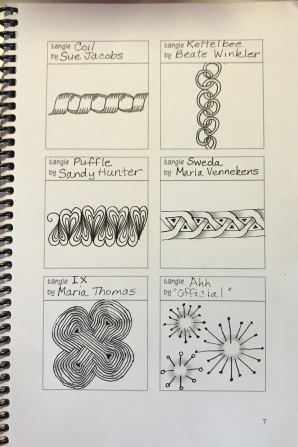Zentangle® is a method of drawing patterns. Many of the designs are repetitive. Working on zentangle is focused and relaxing. It’s a good activity for being present in the moment. Plus, it’s beautiful, and provides lots of opportunities for being creative.
I first discovered zentangle in a round-about way. My husband likes to carve gunstocks. He bought a zentangle book thinking he could use some of the designs in his carving. He changed his mind and gave the book to me.
You know how when you’re planning to be a certain car, every fourth car you see on the road is the car you want? Well, I began seeing zentangle online, on blogs, on social media, on YouTube. It made me want to learn more.
I discovered a Facebook group called Tangle All Around. Alice Hendon, the administrator, offers weekly challenges: 7 tangles (designs to try), a string (a way to segment your drawing surface so you can fill each section with a different tangle), and a dare (suggestions for using your imagination to create variations for a tangle, or to come up with your own design).
This year, she came up with the special project, which she calls “Zen-untangled.” Over the course of 25 weeks, the participants are making a keepsake notebook of the 101 “official” zentangle patterns. I am way behind in mine (my completed pages are the images in this post), and I have entered mine in a different order, skipped some, and added others. But it’s a very convenient way to have a reference of the tangles I like or am interested in incorporating into a project some day.
If you’d like to learn more about zentangle, it’s been a frequent topic on ARHtistic License.
If you like this post, please spread the joy! Share on all your social media.



























![a-to-z HEADER [2020] to size v2](https://arhtisticlicense.files.wordpress.com/2020/03/a-to-z-header-2020-to-size-v2-e1585698284578.png?w=652)

 Xenophobia is the fear of foreigners. It can be manifested as barring of immigrants, refusal to do business with people from other backgrounds, and victimization of foreigners.
Xenophobia is the fear of foreigners. It can be manifested as barring of immigrants, refusal to do business with people from other backgrounds, and victimization of foreigners.









